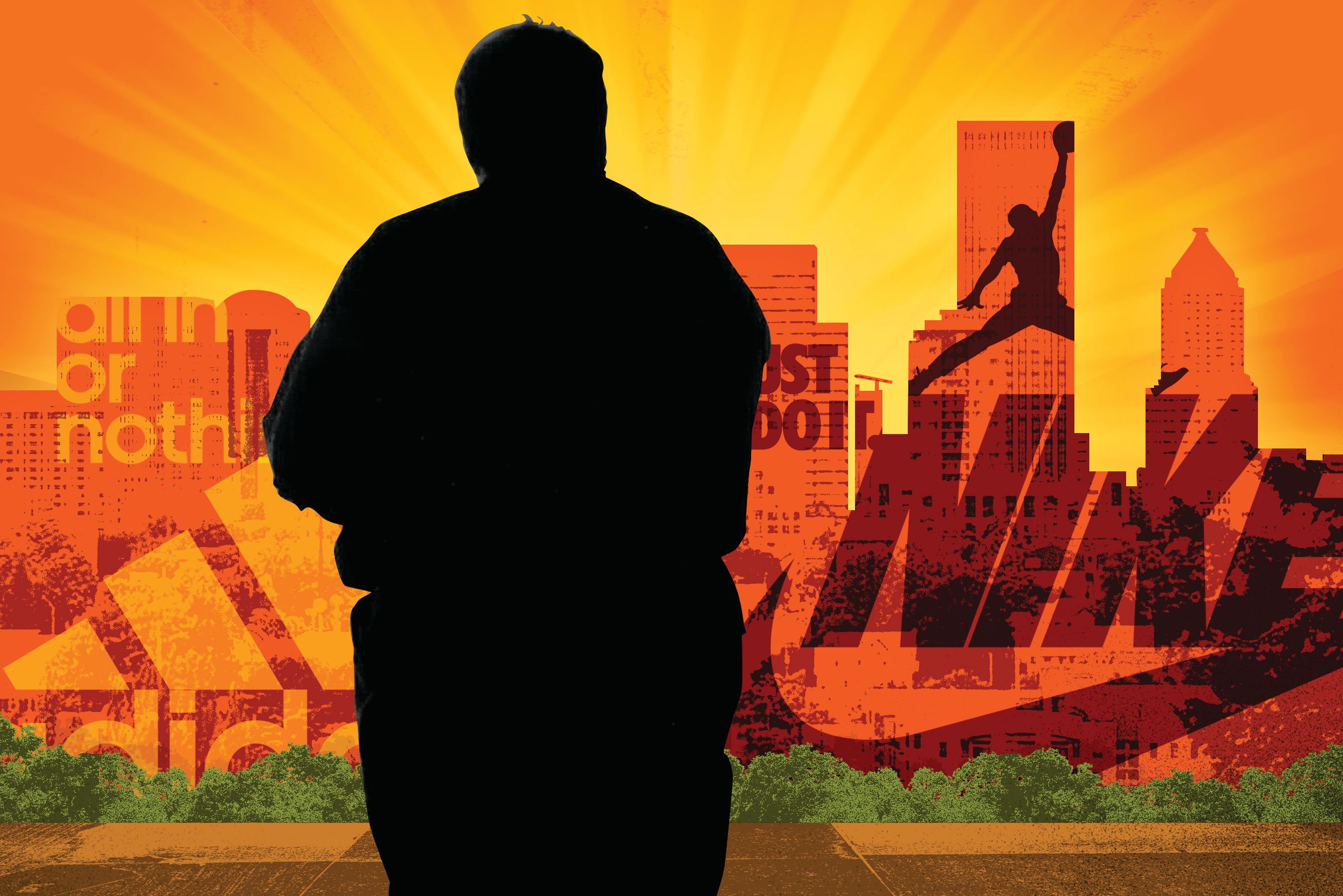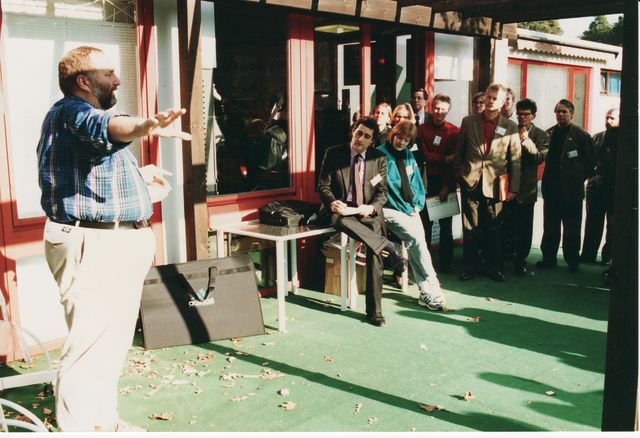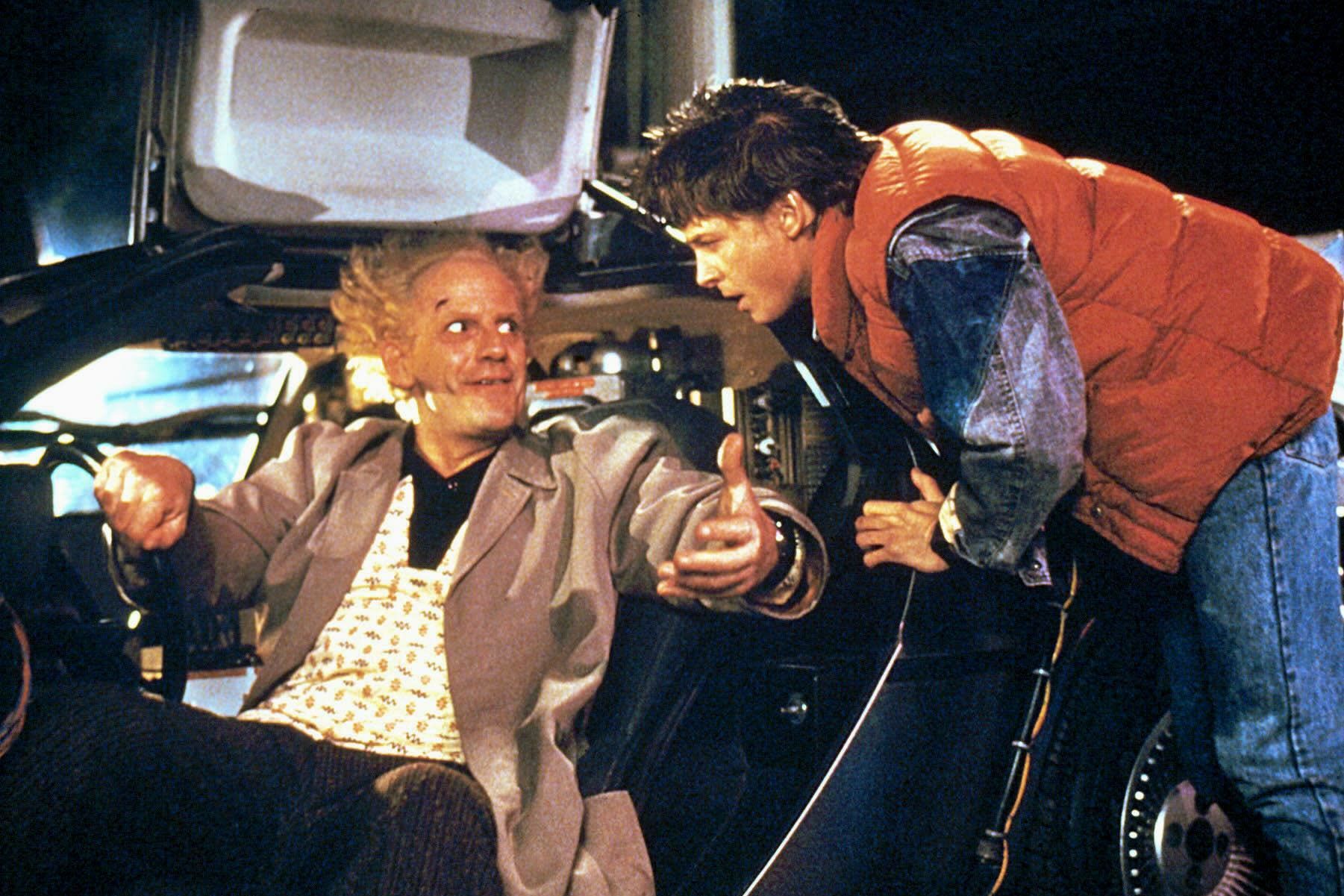
Meet the Man Who Reinvented Nike, Seduced Adidas, and Helped Make Portland the Sports Gear Capital of the World

Rob Strasser, who knew his way around a military metaphor, addresses the troops at a corporate retreat.
Image: Courtesy Peter Moore
On a stifling hot Saturday in the summer of 1984, three men met in the Washington, DC, office of sports agent David Falk. Rob Strasser, Nike’s director of marketing, and designer Peter Moore represented the ambitious sportswear company from Oregon. Falk represented a University of North Carolina basketball star who’d decided to skip his senior year of college and enter the NBA draft. The air-conditioning in Falk’s building didn’t run on weekends, making Strasser, then 36 years old, bearded, and about 300 pounds, perspire even more than usual.
Falk made his pitch, more like an unequivocal demand: if Nike wanted Michael Jordan, Jordan needed his own signature line of shoes and apparel, up-front advertising support, and a cut of future sales. All this was essentially unheard of—a stunning deal for a rookie in a team sport, just one knee injury away from disaster. Adidas and Converse would later tell Falk it would never work.
But Falk had dealt with Strasser for years. They trusted each other. The agent would tell Strasser about such-and-such young star, Strasser would ask Falk what he wanted for the athlete, and with little fuss they’d settle on a price for the prospect to wear and market Nike gear. (Now and then, as was the case with quarterback Boomer Esiason, Strasser didn’t even know what position the person played.) Nike’s top brass had seen the superstar-driven strategy work well with tennis, thanks in large part to John McEnroe. Now Strasser and his team wanted to make sports heroes a cornerstone of the business. “We’re going to Washington today to negotiate for Michael Jordan,” he told colleagues the day before meeting with Falk, according to one account. “We’re going to create shoes, advertising, and whatever else goes with him. If Jordan does what we think he can, and if we can execute, this can be big.”
A huge if. But success would put Nike that much closer to achieving its grand plan: to dethrone Adidas, become the world’s dominant athletic brand, and shift the epicenter of the sporting goods world from Europe to Oregon.
Today, about 32 years after that meeting in DC (and 23 years after Rob Strasser died), Nike’s mission has been accomplished. This March, London-based trade journal The Business of Fashion ran the headline: “Why You Need to Move to Footwear’s ‘Silicon Valley.’” That story—just one of countless testimonies—cited the 14,000 jobs and 800 companies percolating in the Oregon sportswear industry. This summer, cofounder and icon Phil Knight will step aside as Nike’s chairman after building the company into a $30-billion-a-year juggernaut that defines Oregon’s effort to remake itself in a new economy. At times, it’s hard to see where Nike’s influence over life here actually ends.
Adidas has perched its North American headquarters on the bluffs of North Portland, the better to battle its archrival. Deeper in the sportswear “ecosystem,” one finds outdoorsy Keen; a design unit for Under Armour; Nau, once a buzzy start-up, now owned by a South Korean wholesaler; Columbia, a historic Portland outfitter repeatedly reborn; and many other sports apparel businesses. Wieden & Kennedy, the ad agency that made its name building Nike’s image with campaigns like “Just Do It,” sits at the center of a broader “creative” industry of firms and freelancers. In a larger sense, the gestalt of 21st-century Portland—where the dominent cultural style combines antiestablishment ethos with relentless ambition—relies in large part on Nike’s money, clout, and aesthetics.
It’s quite possible that none of this would have come to pass without the gargantuan presence of Rob Strasser: the man whose unrestrained style earned him the nickname “Rolling Thunder.”
Strasser and Moore didn’t know much about Jordan. But Strasser, perhaps more than anyone, believed in star power. In a 1983 memo, he wrote: “Individual athletes, even more than teams, will be the heroes; symbols more and more of what real people can’t do anymore—risk and win.” At that moment, Nike itself desperately needed a win. After the company went public in 1980, its stock languished. In 1984 the company posted its first losing quarter ever. As layoff notices landed in a monthlong wave that some within Nike called the “St. Valentine’s Day massacre,” America fawned over newcomer Reebok, which had snuck up on Nike to capture the era’s aerobics boom.
Some of the conversation between Strasser, Moore, and Falk is now legendary, although accounts differ slightly. Strasser asked what this signature line would be called. Falk remembers that he said: “The Michael Jordan Line, of course.”
Strasser and Moore, according to Falk, were unconvinced. Jordan was a 21-year-old basketball player, not a supermodel.
“What should it be called, then?” Falk asked.
“That’s the trick,” Strasser said.
A moment later, Falk recalls, he suggested “Air Jordan.”
“The moment I said it,” Falk recently told me, “Moore was sketching in this pad that he carried everywhere,” mocking up images. On the flight back to Portland, Moore asked a flight attendant for a set of wings, the kind airlines give kids. That little pin became the inspiration for a logo featuring the words “Air Jordan” arced over a basketball, set between two wings in flight.
Rob Strasser grew up in Milwaukie, attended Willamette University, got his law degree at Berkeley, and returned to Portland to begin climbing the ranks at a local law firm. In 1973, when he was 26, the firm assigned Strasser to a client locked in an international dispute: Blue Ribbon Sports, founded by ex-Cleveland High and University of Oregon track athlete Phil Knight, who had teamed up with his old college coach to sell imported running shoes. Blue Ribbon was battling Onitsuka, a Japanese manufacturer and former partner. Strasser and Knight, who both cared about sports far more than they did corporate-world etiquette, hit it off easily, and Knight soon hired Strasser away to work for the company that would be renamed Nike.
In his new memoir, Shoe Dog, Knight writes: “Strasser was our five-star general, and I was ready to follow him into any fray, any fusillade. In our fight with Onitsuka his outrage had comforted and sustained me, and his mind had been a formidable weapon.”
After a couple of years, it became clear to Knight that Strasser wasn’t just a sharp lawyer—he was a deal-making wizard. “I was sending him into every negotiation with total confidence, as if I were sending in the Eighty-Second Airborne,” writes Knight, in yet another deployment of the military metaphors so popular among people who make shoes to wear while playing games. Strasser even earned a reputation as someone who could underscore a point by hurling a book across a room.
“[H]e just didn’t care what he said or how he said it or how it went over,” Knight recalls in his memoir. “He was totally honest, a radical tactic in any negotiation.” Strasser’s impolitic, party-going personality made him an easy fit with Knight’s other lieutenants of the era—or, as they called themselves, the Buttfaces. (En route to annual meetings in Sunriver or on the Oregon Coast, they would stop along the way to drink and shoot pool. And that was only the beginning of the weekend.)
Strasser became the company’s marketing director, and exhibited an almost preternatural grasp of brand identity—in particular, how Nike’s insurgent play for control of the sportswear market relied on a combination of athletic performance and irreverent bravado. “Many afternoons,” writes Knight, “I’d sit around the office with Strasser, trying to figure out why some lines were selling and some not, which led to broader discussions of what people thought of us [Nike] and why…. We were more than a brand; we were a statement.”
Sometime near the end of 1984, for example, Strasser traveled to London to woo the All-England Lawn Tennis Club, overseer of Wimbledon. (This was just a couple of years after McEnroe, a Nike man, torpedoed the decorum of Wimbledon’s Centre Court with his legendary You cannot be serious! tirade.) For his pitch, Strasser printed out large black-and-white pictures of Wimbledon’s courts after they had been bombed by the Nazis. The tagline: “Brought to you by the people who wear three stripes,” a bald-faced reference to Adidas.
The tactic was classic Strasser, for its bluster but also its precision: one of the club officials listening to the pitch was a decorated World War II veteran—and Strasser knew it.
His accomplice on the trip, as on many other occasions, was Moore, a young designer who’d joined Nike in 1977. The two men gelled: both loathed meetings and bureaucracy and possessed a frenetic desire to experiment. (As work at Nike picked up pace for Moore, he began collaborating with a young copywriter from the William Cain advertising firm named Dan Wieden. Wieden soon split off to form his own firm, with Nike as its cardinal client.)
Strasser and Moore put great emphasis on presentation. In an age before PowerPoint or the pat ritual of the TED Talk, Nike’s marketing team went all in on videos, music, even smoke machines. Results could be mixed. For one big sales event in Sun Valley, Idaho, they assembled a production on the theme of (surprise!) heroes, featuring slides of icons—Jimi Hendrix, Mickey Mantle, Winston Churchill, and ... Mao Zedong? A few minutes in, the smoke machine went into overdrive. Moore thought Strasser was yelling for more smoke, when in fact he was shouting Moore’s name to get him to shut off the machine.
At Wimbledon, however, overkill seems to have worked. Moore remembers the session ending with an official telling the visitors that Nike would henceforth be the only four-letter word heard at the prestigious club.
When crunch time came in the 1984 negotiations to unite Jordan and Nike, Strasser faced one final obstacle: Michael Jordan. The kid wanted to sign with Adidas, even after Strasser and Falk, Jordan’s agent, had agreed to terms.
Nike brought Jordan and his parents to Oregon to hear Strasser’s presentation. He talked about Nike’s winning advertising campaigns, and about building up Jordan’s image. Moore showed off prototype apparel and a pair of shoes cut in the Chicago Bulls’ colors of red, white and black. The only response Jordan gave was something about missing the “Blue Heaven” colors of North Carolina. Otherwise, he kept quiet for much of the meeting. The night after the pitch, a limo took the player and his parents to meet Strasser, Moore, and a bunch of Nike people at a downtown restaurant called Broadway Revue.
Jordan recently told USA Today: “I absolutely fell in love with (Strasser) when he actually made the first presentation of the Jordan thing, the Air Jordan concept.” Nevertheless, Jordan still held out for Adidas: “I went back to my Adidas contact and said, ‘This is the Nike contract—if you come anywhere close, I’ll sign with you guys.’” Adidas didn’t.
That fall, as Jordan debuted in Chicago, Strasser learned that a $1,000 fine had been levied against the superstar. Unbeknownst to the designers and marketers in Beaverton, the NBA—as if channeling the hauteur of the All-England Lawn Tennis Club—demanded that all players on a team wear similarly colored footwear, and that the color match the team’s primary uniform color. According to an account in a book written by Strasser’s wife, Julie, backed up by others’ memories, Strasser told Jordan to wear the shoes. Nike would cover the fines—and reap the publicity.
The dust-up hit just the right rebel note, and Strasser and his marketing team adroitly capitalized. They cut a television commercial featuring a now-famous voiceover: “On September 15, Nike created a revolutionary new basketball shoe. On October 18, the NBA threw them out of the game. Fortunately, the NBA can’t keep you from wearing them. Air Jordans. From Nike.”
Air Jordan became a culture-rocking sensation, so coveted the brand bred a dark side: a series of small riots, assaults, and even murders over the shoes, which some high schools would ban before the ’80s were out. The link to Jordan, who became the greatest pro basketball player of all time, transformed Nike’s fortunes. To date, the Jordan line has delivered a reported $2.6 billion in sales.
Strasser’s biggest win ever stoked his confidence. At one point, when he encountered internal opposition to the expansion of the Nike Air product line, he responded: “Fuck the world. Fuck the numbers. Air feels right. Air feels like Nike.” And he was right, in that instance and many others.
Soon after Jordan flouted NBA rules to debut his shoes, Nike was on track for global domination. In 1985, Knight told Willamette Week that “a whole lot of people were responsible” for the company’s turnaround, “but Rob is the M.V.P.” That story was about Strasser and the Air Jordan deal, and it was titled, “The Man Who Saved Nike.” According to Julie Strasser’s 1993 book Swoosh, Rob didn’t like the savior talk. It may have been tactical, but he even told the WW reporter as much: “Hey, there ain’t no heroes here.” Moore felt similarly about Strasser, that he just “wanted to be one of the guys.” One of Strasser’s favorite sayings, recalls daughter Avery, was: “Can’t a guy just be a guy?”
One day in 1989, a young job seeker named Tom Hughes showed up for an interview with Strasser. He walked into the room to find Strasser, all beard and bulk, hands folded.
“Hello, Mr. Strasser.”
“Cut the bullshit. Call me Rob. So, can you work hard? Are you loyal?”
“Yes, sir.”
“Cut the ‘sir’ crap. OK. Don’t fuck up.”
That was Strasser: a success on his own terms, no apologies. When Nike went public, he was an instant millionaire at 33. He was never a showy rich guy, but he was a fun rich guy. He preferred Hawaiian shirts to suits. Rumor had it he put a $25,000 European treasure hunt in his will, as well as a chicken costume. Fast cars come up in conversations about him, as does cocaine—this was the 1980s, remember. More than anything, Strasser enjoyed vacationing on the coast, often in Manzanita, or taking friends out on his 48-foot party boat to bomb up and down the Willamette.
Hughes, now corporate affairs manager at Adidas, recalls a night on the boat when Strasser, his wife, and others were entertaining business partners visiting from France. Another boat had just passed. “Jump the wake!” Strasser yelled to Hughes at the helm. Hughes hit the throttle as commanded, and the boat bumped up then thumped down, hard, sending glasses flying. Hughes says Julie hurried up on deck, yelling that all the crystal on board had shattered. “Rob looked at me and winked with this childlike twinkle,” says Hughes. “Then we toasted.”
At work, though, Strasser was dead serious—especially about crushing Adidas. “Rob referred to Adidas as ‘the Germans,’” recalled Falk. They were the sworn enemy, and Strasser was as “passionate in his hatred” as anyone in the company, including Knight. In 1981, Strasser moved to the Netherlands, charged with building Nike business on the Germans’ doorstep. “We can’t aim a howitzer at Adidas’ homemarket heart,” he wrote in one memo. “And we can’t fight them everywhere else at once. Not now.” What Nike could do instead was pursue a country-by-country guerrilla approach, steadily chipping away at its rival’s market dominance.
As the years went by, however, some of Strasser’s joie de guerre drained away. If one accepts the account coauthored by his wife, by 1987, Strasser had grown exasperated; the huge company he now worked for no longer felt like the maverick start-up he had nurtured. Strasser and Knight increasingly saw things differently. In his memoir, Knight attributes it to ego: “He felt that he should no longer be taking orders from anyone, including me. Especially me. We clashed, too many times, and he quit.”
Moore rejects any suggestion that Strasser aspired to run Nike or that he couldn’t take orders. Still, he says, “Rob’s persona was as big as Nike itself,” and perhaps that bothered Knight.
Rob “loved problems,” says Hughes. “He liked to fix things.” What problems remained at Nike, by then a brand approximately as recognizable as Coca-Cola? “Smart and talented people like Rob are never satisfied,” Moore told me. “It’s like great painters who are reluctant to sell anything because the work never feels quite done. We had, and we knew we had, put Nike on a path. But we wanted to keep doing new things.”
After Strasser left Nike in 1987, he and Moore launched their own consulting firm, Sports Inc. They dabbled in new brands, like a style-focused shoe line called Van Grack. At one point—and here memories of exactly what transpired differ—they may have attempted to poach Jordan from Nike. Even so, a certain restlessness endured. “I think Rob wanted back in the big-time,” says Moore. “The limos, working with top athletes, the huge marketing budget, the deal-making—it was addictive.”
Sometime in 1989, less than two years after Sports Inc began, Strasser’s phone rang. The Germans wanted to meet.
After landing in Munich, Strasser, his wife, and Moore drove through the Bavarian countryside to the small town of Herzogenaurach, Adolf “Adi” Dassler’s birthplace and home to Adidas world headquarters. It was a cold, gray autumn morning. Then they saw it: a monolithic building, an almost cartoonish Soviet-style fortress, topped by a neon blue trefoil spinning in the fog.
“Oh, fuck,” said Moore. “Let’s get out of here.”
That night, over dinner with Adidas’s CEO and other company officials, Strasser was his usual life of the party, enjoying a steak and more than a little red wine. Moore, still perplexed about why he was there, remained guarded. After all, he and Strasser had helped orchestrate Nike’s takeover out of the global sportswear market’s top slot. He confessed his discomfort to an Adidas exec.
“No offense, but for a decade, our mission was to kick your ass.”
“But Peter,” the man replied politely. “You did kick our ass. That is why you are here.”
The next morning, Moore wandered into the Adidas company museum, a concentrated history of modern sports told through footwear: Spikes worn by Jesse Owens at the 1936 Olympics in Berlin. Boxing shoes worn by Muhammad Ali. Stan Smith’s Stan Smiths, and the pair of soccer cleats that would become known as the Copa Mundial. On and on it went. “I suddenly realized that, with the exception of the waffle trainer and that air bag [Nike Air Max], this guy Adi was the father of 90 percent of the industry,” says Moore. (Note: Moore still consults for Adidas.) Moore wondered how Adidas had managed to “fuck it up so bad” in recent years. Maybe he and Strasser could be helpful after all.
They left Germany with an agreement to try and revive the brand—somehow.
Peter Moore’s studio is wedged next to I-405 in the Pearl District. Above the entryway is a large silver question mark. When I arrive, I can see Moore through the window, looking over a stack of prints. He is now 72 years old. He answers the door after some loud banging and arm-waving (he is nearly deaf), and then we sit down at a large, glass-topped table to discuss his business partner of nearly 20 years.
At one point, Moore brings out an old photo album with pictures of Strasser and a dozen young professionals on a visit to the Oregon Coast. They are dressed for the early ’90s, in light-blue jeans, big hair, colorful sweaters. This was the original team that worked on an Adidas project known simply as “Equipment.”
Equipment was Strasser and Moore’s strategic concept to get Adidas off life support and begin its recovery. The austere name signaled radicalism through reduction. “The idea was to create products, shoes, and apparel that were to be ‘the best of Adidas’—the essentials,” Moore recalls. “All you need, and nothing more.” In other words, strip the brand down to its iconic core, an Adidas everyone would recognize. Moore and Strasser also advised ditching the trefoil for three streamlined, tilted stripes, and a limited four-color palette, which Moore says was then unheard of.
And one last thing: move Adidas’s North American headquarters from New Jersey to Portland.
After recovering from the initial shock, Adidas top brass said yes.
Strasser was now very much back in the big time, and back to working nonstop. He would spend day and night reading the rolls of faxes coming into Portland from Germany. He’d work all day, then he and his team would go out for dinner and drinks.
Hit repeat so many hundreds of times. Mix in stress, travel, and an ironic but chronic lack of exercise, and a person’s health will suffer.
“He once tried to do some walking meetings and things like that, but it never took,” Moore recalls. “Mostly he just got defensive.” Strasser knew he had a weight problem, but he either couldn’t or didn’t want to change his ways. Others like to say he “lived the life he wanted to.”
The Adidas America team was at a sales meeting in the resort town of Sonthofen, in southern Germany, when Strasser turned to a colleague and said: “I think I’ve got something going on here,” gesturing at his torso. An ambulance rushed him to a local clinic; a few days later, a chopper transported him to Munich. A cardiologist there said he couldn’t be sure what was happening—Strasser’s size made diagnosis difficult—but it was probably a heart attack. Strasser returned to the US for treatment, and even told Moore that he planned to change his lifestyle. But his condition was already worsening.
Rob Strasser died on October 30, 1993. He was 46. Thousands of people attended his memorial service at the University of Portland’s Chiles Center, many of them wearing Hawaiian shirts. Phil Knight didn’t show.
Despite his lasting impact on our economy, and even the personality of this town, Strasser isn’t known to many people outside of those two rival companies, and even within them his role is fading into ancient history. Why? Possibly because his work was vital to both, which makes it difficult to neatly write him into the mythology of either one. For Adidas, it was a brand revival conceived and executed by a fat American ex-Nike guy and his arty partner. For Nike, Strasser’s achievements are overshadowed, if not severely tarnished, because he was a traitor. “It might have been okay if he’d just quit,” writes Knight. “But he went to work for Adidas. An intolerable betrayal. I never forgave him.”
Yet the fact that Strasser doesn’t easily fit the lore of either firm underscores the debt Portland owes him: his loyalty to this city, above either company, helped draw so much investment, industry, and creativity here, and helped make Portland what it is today.
As for Strasser’s ultimate allegiance, Moore still suspects that if Knight had ever called him to make peace or vice versa, the two men could have reunited at Nike. In light of the fact that that never happened, Moore suspects that up in heaven somewhere, a burly Oregonian is wearing Nike on one foot, and Adidas on the other.
Illustration by John Ritter.




